
How do you find and deal with duplicate Google listings?
They say imitation is the sincerest form of flattery. But on Google Maps, it is anything but flattering to find out your Google My Business listing has a doppelgänger. A duplicate GMB listing can hurt your rankings and put your business listing at risk of suspension. Meanwhile, it’s not uncommon to see your competitors spamming Google Maps by creating multiple listings for one business. So why do duplicates seem to help some businesses and hurt others? In this guide, we’ll help you determine when you should remove a duplicate and when you should merge, and show you how! But first let’s look at what a duplicate is, and how to see if your business has any harmful doppelgängers hanging around.

What is a Duplicate Listing? Why is it Harmful?
A duplicate GMB listing is an additional listing for a business or place that already has a listing. These listings can cause problems for business owners and users alike. Duplicate listings can divide ranking power and review counts, outrank or hide the owned listing, and cause confusion and distrust for search engines and searchers alike.
Where do Duplicate Listings Come From?
There are few possible sources for duplicate listings:
- Added by a user (Likely unclaimed. Difficulty to remove: Easy)
Google Maps users can add missing places, including businesses they don’t own and aren’t affiliated with. When a new place is added manually by a user, Google should surface any existing listings that share the same name or address, but if it doesn’t make the connection, or if the user creates a new listing anyways, a duplicate is born.” - Forgotten listing or previously verified by the business (Likely claimed. Difficulty to remove: Medium)
It’s possible a business lost or forgot how to access their listing, or that a past marketer never gave them access to their listing and the business later created a new listing rather than trying to claim the old listing. - Automated with information scraped from other online sources (Likely unclaimed. Difficulty to remove: Easy)
Some GMB listings are created automatically as Google detects unintended variations in business information in sources that provide business information to Google. - Spam created by a business against Google My Business guidelines (Likely Claimed. Difficulty to remove: Hard)
Businesses not following Google My Business guidelines may create multiple listings with keyword-stuffed business names or unique categories to increase their reach.
How to Find Duplicate Listings
Finding a duplicate listing comes down to three major identifiers: Name, Address, and Phone number (NAP) and all their possible variations.
Name
A business’s name is one of the most important identifiers. Lucky for us spam-fighters, we can use that to our advantage. To find duplicate listings, search for the business name on Google Search and see if multiple listings populate. If so, look in Maps to see where these listings are located and determine if they are duplicates. In order to stay under Google’s eye, duplicate listings will add keywords or mix up their business name to not be detected.
Find out the businesses registered name by looking for signage in street view, visiting their website and assessing their logo, or searching for them in a local directory or Secretary of State business entity search (U.S. only).
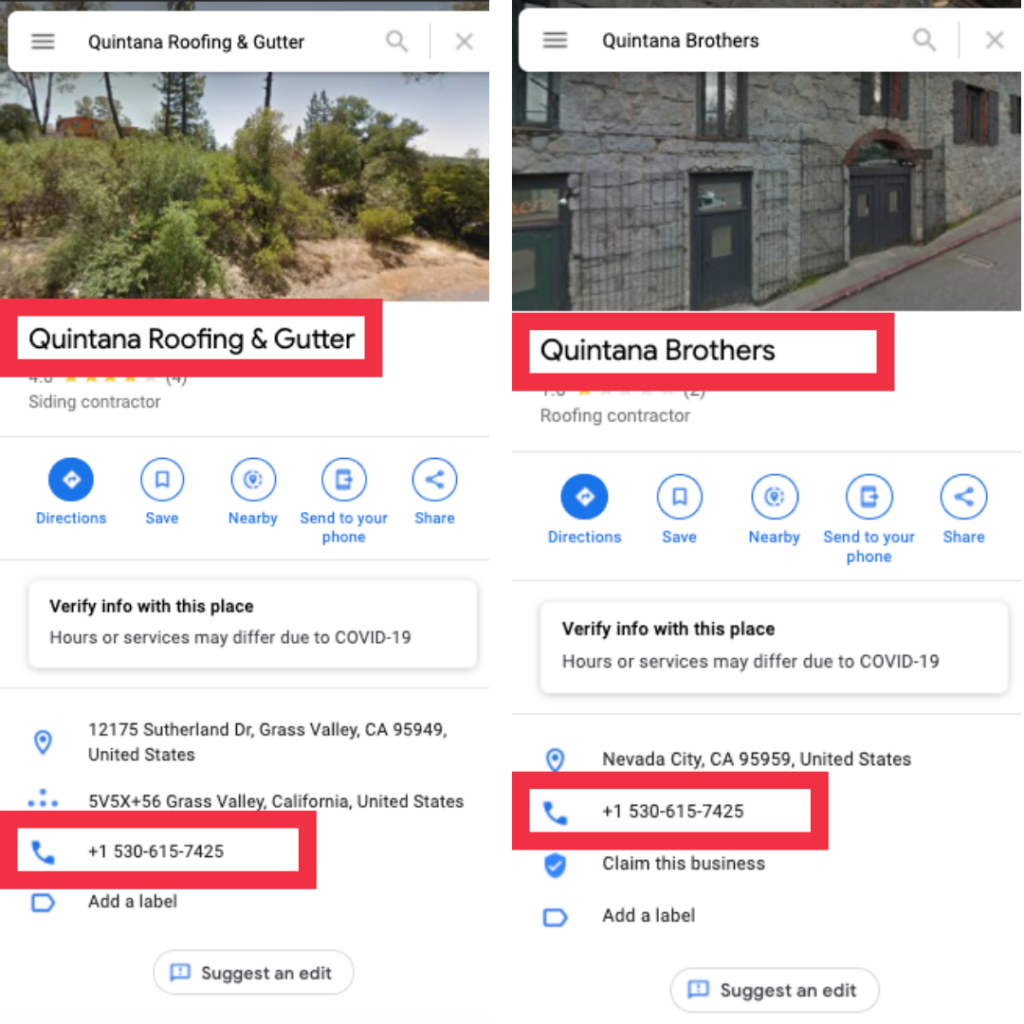
Address
We have found that businesses will frequently hide under the radar from Google’s spam detection by forgoing adding a suite number that they have on their other listing, moving their map pin, or simply creating a second listing as a Service Area Business. Make sure to look into these inconsistencies:
- Do the suspected duplicate listings have the same phone number?
- Are they located in the same building?
- In map view, is the business in the parking lot or down the street?
If so, these are red flags that the business is using duplicate listings to rank.
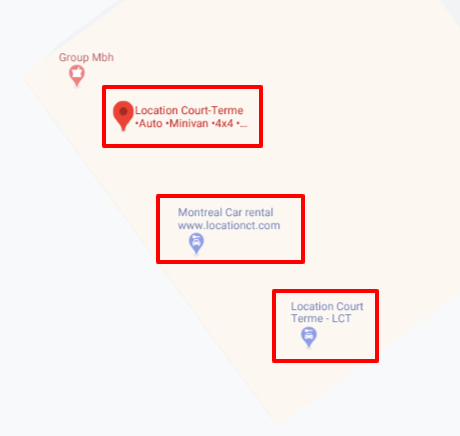
Phone Number
Lastly, we can use phone numbers to search for duplicate listings. We have found that businesses will use different phone numbers, whether it’s a call tracking number, a mobile number, or a different number all together to be filtered out as a duplicate listing. Again, see if the other listings have similarities in their name, address and website. In addition, you can visit their website or other directory pages (YELP or BBB, for example) and see if the number is consistent on those pages. Often, only one main number will be associated with the business.

How to Handle Duplicate GMB Listings
Now that you know how to find a duplicate listing let’s jump into action to get duplicate listings under control. Before we look into merging the listings, let’s look at how you can clean up duplicates of your listing and what you can do about a competitor’s spammy duplicate listings.
Handling Duplicates of Your Listing
1. Get ownership of the listing
When finding a duplicate of your business, we have found that a business owner may already own the duplicate listing under a different email or a different owner. In the case of practitioners or practices, a previous owner may have created the listing without the current owner’s knowledge. Additionally, Google’s AI may even create a duplicate listing. Regardless, when you find a duplicate of your listing we suggest you request ownership of the listing and follow the steps to get the listings merged or removed.
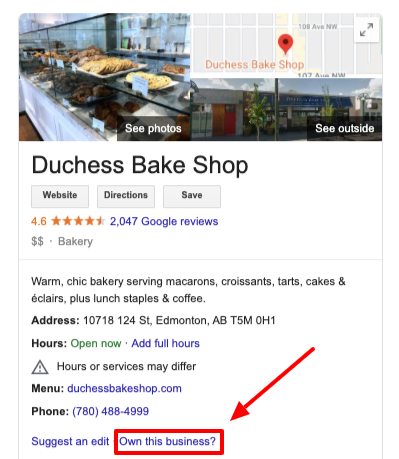
2. Report as Duplicate via Maps Suggest an Edit
In our experience, using the Google Maps “Suggest an Edit” feature to report a duplicate is effective if the listing is not claimed and has consistent NAP with the other listing.
If the NAP isn’t consistent between the two listings, attempt to edit the information with “Suggest an Edit”. Once the edit is approved, use “Suggest an Edit” again to report the duplicate.
You’ll receive an automated email from Google when your edit is approved. The duplicate below was reported via “Suggest an Edit” and the edit was published:
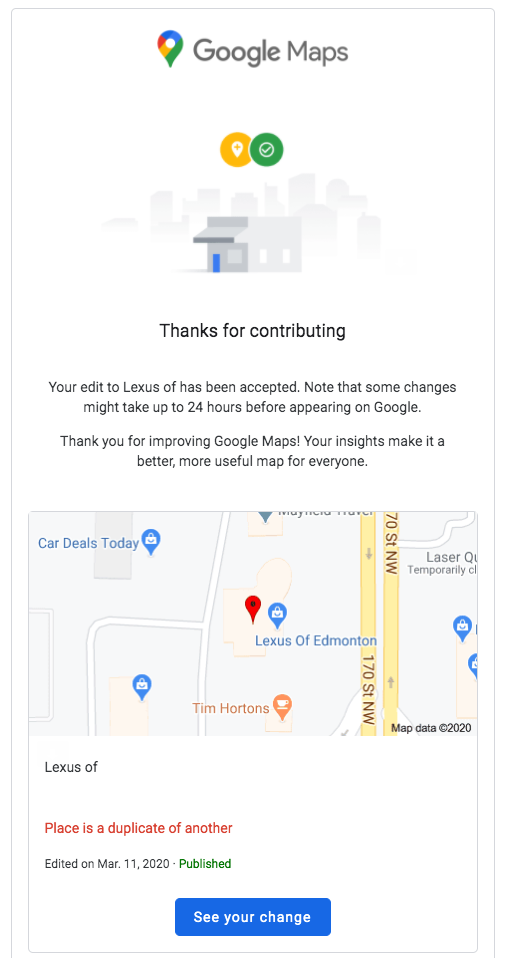
3. Report as Duplicate via the Redressal Complaint Form
If the business has multiple duplicate listings you should head to the Redressal Complaint form. Here you can identify the business, each duplicate listing, and give detailed evidence directly to Google Support.

Handling Duplicates of a Competitor’s Listing
When the duplicates have different categories
We have found that spammy competitors will make duplicate listings to manipulate rankings in different primary categories. This gives them the ability to rank for keywords related to both categories and therefore increases their visibility. This is against Google’s guidelines and gives the competitor an unfair advantage. In these cases, we suggest:
- Compile evidence that the multiple listings are ineligible duplicates for one business
- On Google Maps, Suggest an Edit and select the reason “Duplicate of another place”
- Send a Redressal Complaint form.
When duplicates each have reviews
Duplicate listings will often have 1 or 2 reviews with little to no content to manipulate users and Google into thinking it is legitimate. It’s harder to remove a duplicate listing that has reviews because they add legitimacy to the business. If you find a competitor with duplicate spammy listings with reviews, you can send a Redressal Complaint form or contacting Google Support with evidence of the duplicate listings as using the “Suggest an Edit” feature on Google Maps will likely lead to your edit getting denied.
However, we recommend looking at the duplicate listings carefully (their ranking, categories, names and reviews) as reporting the duplicate could result in Google merging the listings, which would increase the business’s review count and star-rating, which could affect its ranking and yours – for better or worse.
When duplicates don’t have unique information or harming your ranking
It’s possible that your competitor’s business has duplicate listings that weren’t created to game rankings. In this case, we don’t recommend reporting the duplicates as they’re likely not helping your competitor’s ranking.
Merging GMB Listings
To help you navigate the best practices for reporting and merging duplicates, we’ve put our process into a simple flowchart. But first, let’s review when it’s worth merging duplicates, how to tell if a listing is claimed, and Google’s (complicated) process for getting access to a listing claimed by someone else.
When should I merge duplicate listings?
A duplicate listing is worth merging if there are assets that would be valuable to have added to your original listing, such as:
Positive reviews
Having your reviews divided between your claimed listing and a duplicate doesn’t help build your review count, star rating or review frequency. When requesting a merge, specify to Support that you want the reviews on the duplicate ported over to the claimed listing.
History
To determine if a duplicate listing is older than the claimed listing, and therefore has valuable history, examine the listing for user-generated content that pre-dates the claimed listing. Are there reviews, photo uploads or questions on the listing that are older? If the listing is claimed, is the email address for an old business email account or an old marketing company? You can use this information to estimate if the listing is older than your claimed listing.
Higher ranking
Perform a Google search for your keywords, top services and business categories or monitor your rankings with a tool like Whitespark’s Rank Tracker and examine Google Maps, Local Finder and Local Pack screenshots to see if a duplicate is outranking your claimed listing.
How can I tell if a listing is claimed?
Take a look at the listing on Google Maps. In the information section where the address and phone number are, near the bottom, you’ll either see ‘Claim this business’ or ‘Manage this business or neither.
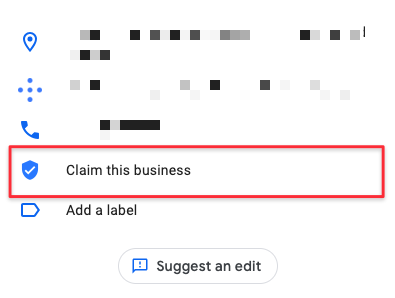
If it says ‘Claim’, the listing is not claimed.
If it says, ‘Manage’ or has neither, it is claimed and you’ll have to go through a verification process to gain access.
How do I request access to a claimed listing?
The process is different for physical locations and service area businesses. Let’s take a look at both.

Physical Locations
Start by trying to claim the listing. A message should appear saying the listing has already been claimed.
- Click Request Access and complete the form, then click Submit.
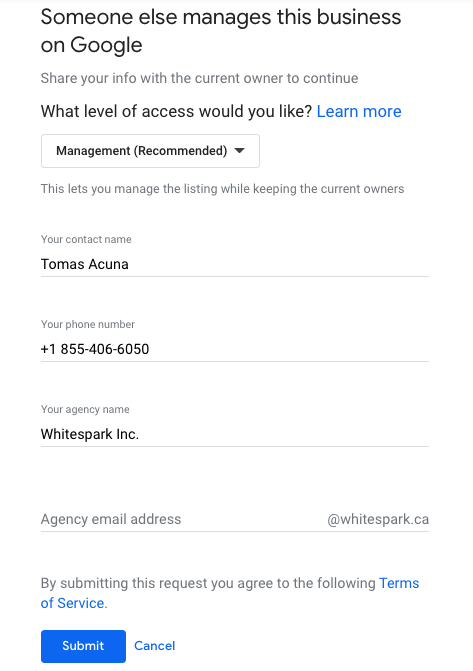
- You’ll receive an email from Google. Save this email in case the current owner denies your request.
Tip: The current owner is given 3 days to approve, deny or ignore your request. Contacting Google Support before the 3 days will not speed up this process.
- If the current owner gives you access within the 3 days, you’ll get ownership. If they deny access (or ignore your request), you’ll have to appeal for ownership.
- Go to the email you saved and click View Request. You’ll see an option to Appeal (if the request was denied) or to Verify (if there was no response). Both start the process of re-verification by postcard.
- Once you get your postcard and enter the PIN, the listing will now be under your ownership. Check the Users list to make sure there are now owners or managers that should be removed.
This process is a foolproof way of returning ownership to the correct party, but unfortunately it only works for physical locations.
Service Area Businesses
The process to get access to a claimed listing is a bit different for SABs. You’ll have to go through the process of essentially creating a new listing. And it feels like you’re actually making a duplicate, but this is Google’s process.
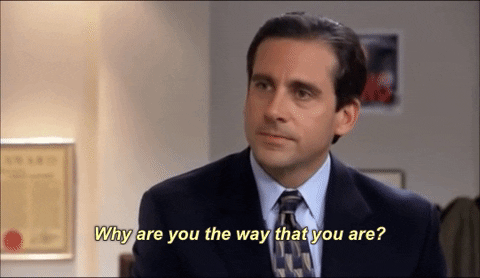
- Go to business.google.com/add, enter all your business information, then click Continue. Follow the process to verify the listing. You’ll receive a postcard to the address you entered while filling in your business information. Verification postcards typically arrive in 10 business days.
- Once the listing is verified, an ‘Owner Conflict’ dialog should appear, indicating the listing is a duplicate. Click Request Access.
- You’ll receive an email from Google. Save this email in case the current owner denies your request.
Tip: The current owner is given 3 days to approve, deny or ignore your request. Contacting Google Support before the 3 days will not speed up this process.
- If the current owner gives you access within the 3 days, you’ll get ownership. If they deny access (or ignore your request), you’ll have to appeal for ownership by contacting Google My Business Support. If you can make a solid case and provide proof for why you should become the owner of this listing, Google support can help make the listing unverified.
Stop Seeing Double
The complex processes and nuances can be confusing when dealing with duplicate GMB listings, but this doesn’t mean you should avoid dealing with them. Duplicates can affect your rankings by filtering out your more prominent listing or negatively impact customer experience by providing incorrect or outdated information. Take the time to clean up your duplicates correctly and you’ll be rewarded with more website visits, phone calls, and walk-ins by putting your best foot forward from the moment a customer finds you on Google.


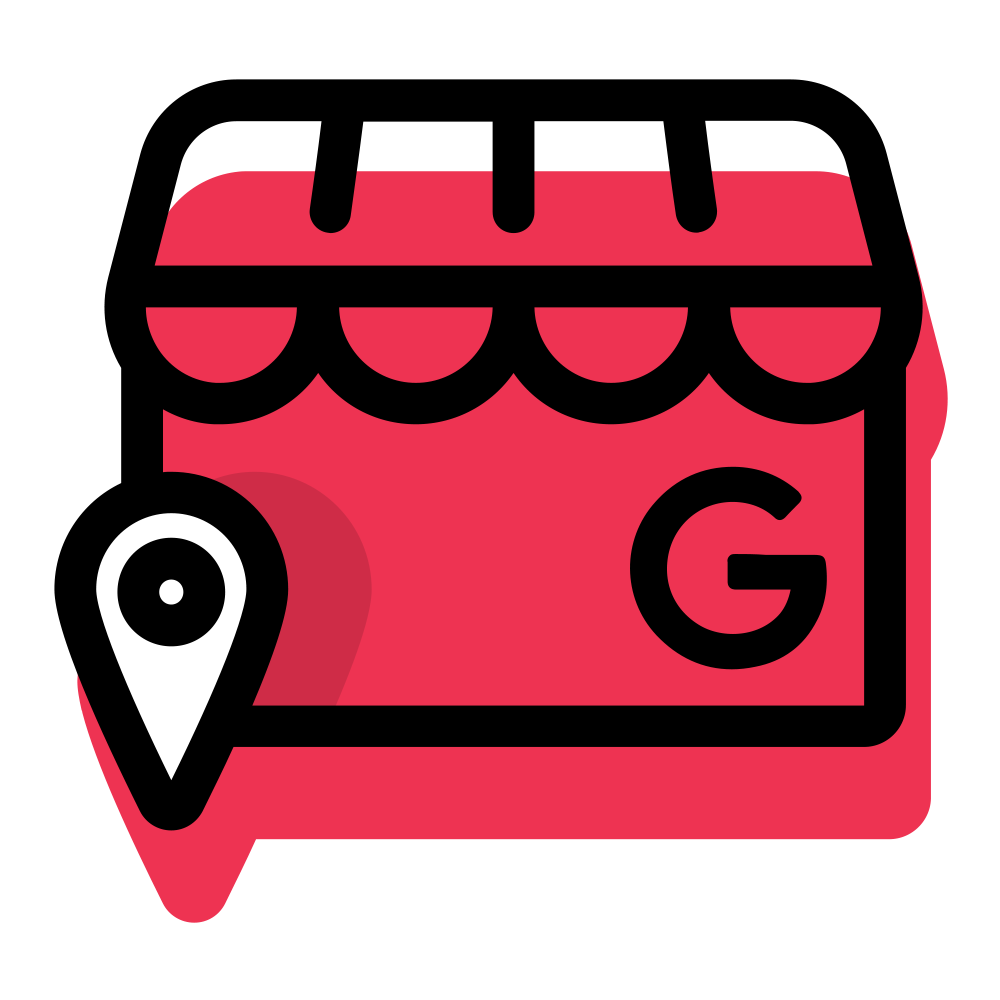
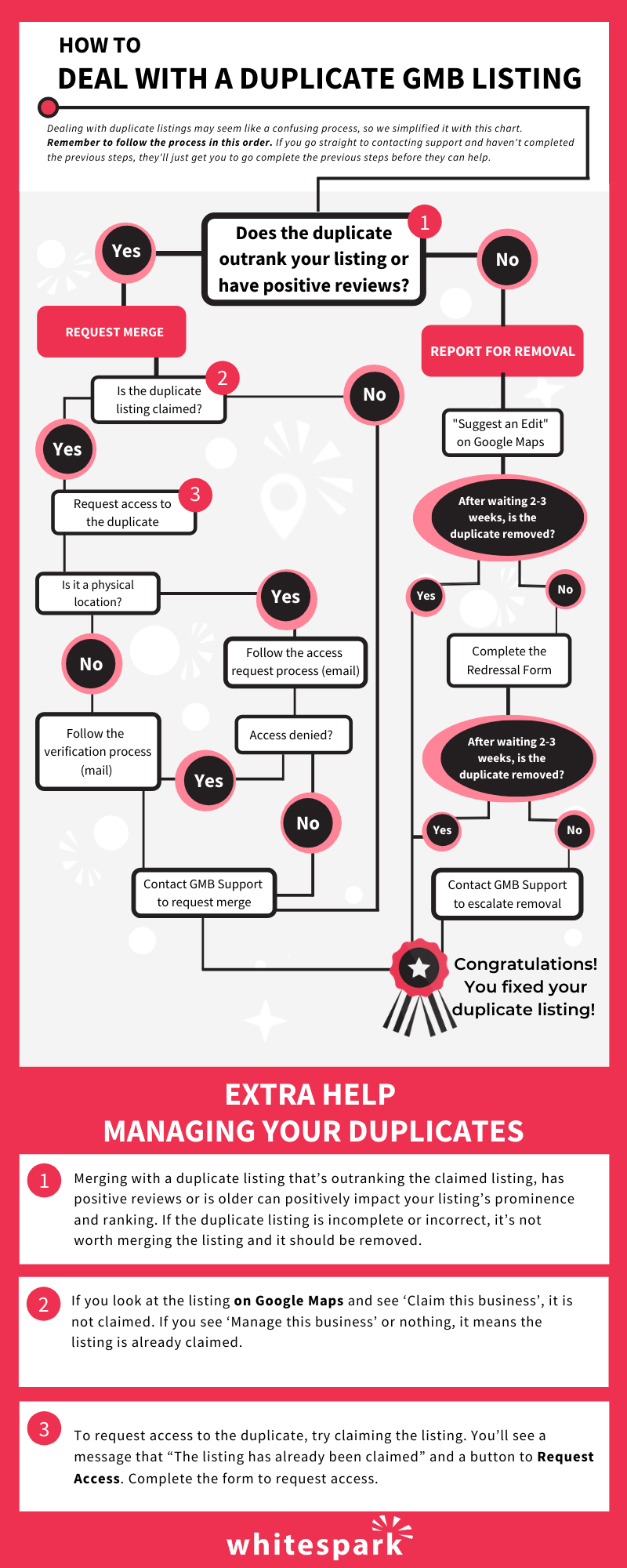










One comment on “How do you find and deal with duplicate Google listings?”
This was really useful! I wonder how much of this is even doable right now with the virus situation. I still have verified listings that aren’t actually listed, and reviews that aren’t showing up yet. Hope it gets back to normal again soon!
Comments are closed.